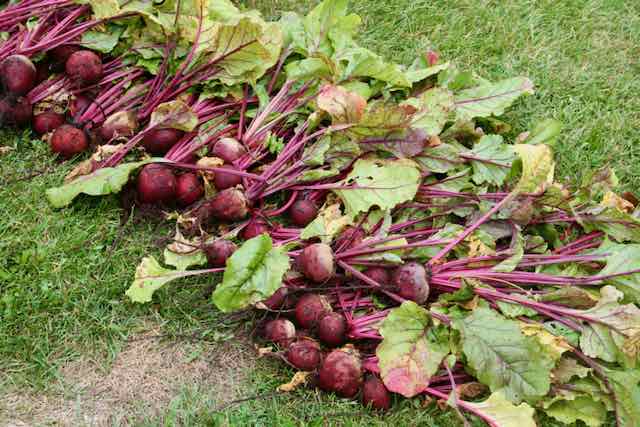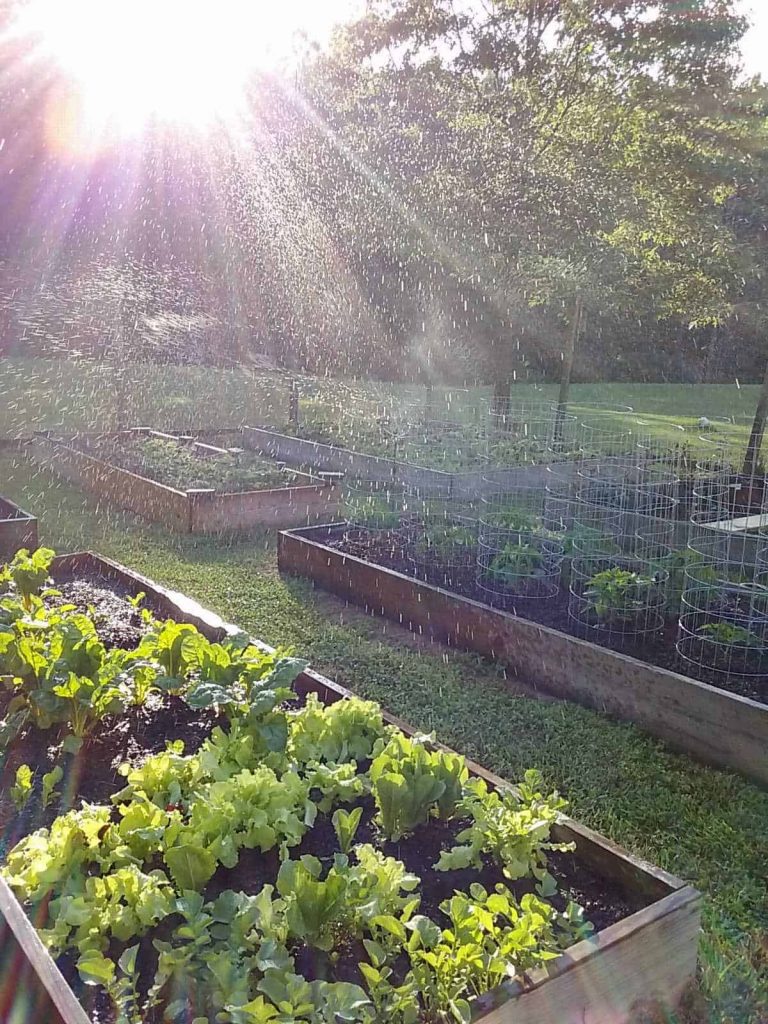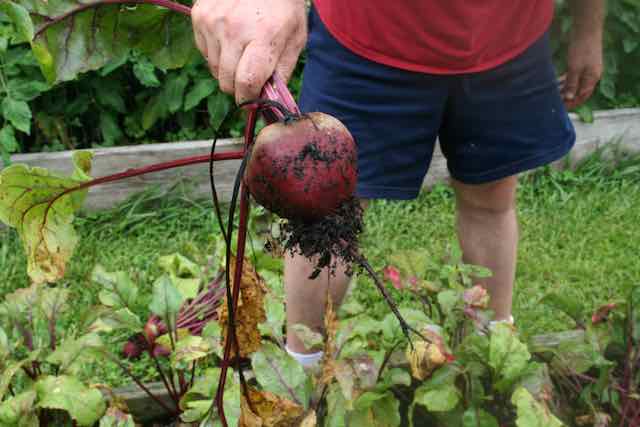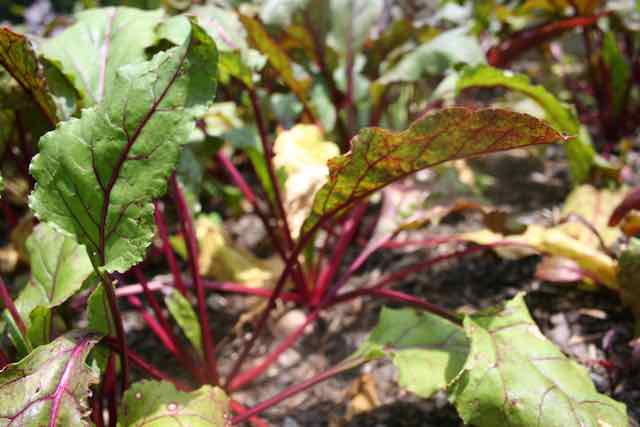I wrote this Ultime Guide to Growing Beets to share my techniques for growing tasty, organic beets.
Beets are a powerhouse of nutrition. Both the beetroot and the leaves and stems are edible. You can also can beets and beet greens to store them for year-round use. Here, I share with you a full guide to growing beets. At the end of this article, there is a list of other related topics so you can learn more and cook what you grow.
Table of contents
What Are Beetroots or Beets?
Beets, also known as beetroot, are a deep red or purple root vegetable. They have a sweet, earthy flavor and contain nutrients, including vitamins, minerals, and antioxidants. Beets can be eaten raw, cooked, pickled, or juiced and are often used in salads, soups, and as a natural food coloring.
Besides their culinary uses, beets have been associated with various health benefits, such as improving blood flow, lowering blood pressure, and enhancing exercise performance. Plus, the greens (tops) of beets are also edible and nutritious.
History of Beets
Beets are the world’s first superfood. Beets (beta vulgaris) were first cultivated in either Germany or Italy around the year 1545 A.D. However, they were grown much, much earlier in human history. There were beets grown in ancient Babylon, and the Greeks and Romans grew them, too. In the Elizabethan era, beets were much favored, and Thomas Jefferson added them to his garden at Monticello.
Beets, it seems, have been a favorite in gardens for a long time.

Growing Beets from Seeds
Growing beets from seed is a straightforward process and can be quite rewarding. Here’s a step-by-step guide to help you get started:
Planting Time
Beets prefer cooler weather, so you can plant them in early spring (2-4 weeks before the last frost) or late summer for a fall harvest. We have grown beets here in Virginia (Piedmont, Zone 7B) in both spring and fall, and the spring crop far surpasses the fall crop in quality and quantity. We usually plant a “Detroit Dark Red” variety of beets in April and harvest them in late June to early July.
Location
Beets need well-drained, loose soil with plenty of organic matter. A sunny spot with at least 6 hours of sunlight per day is ideal. You can plant beets in containers or pots, raised beds, or directly into garden or ground soil. I have grown them in all three conditions. If you grow beets in containers or pots, choose deep pots to give the roots plenty of room to grow.
Soil Preparation
After choosing a sunny location for your beet plants, get a soil test done if it is a new vegetable garden area. A soil test conducted by your local Cooperative Extension office will tell you exactly what you need to add to the soil to grow the best beets.
Beets prefer a soil pH of 6.0 to 7.0. Prepare the soil by adding compost or manure and turning it in with a pitchfork. Beetroots like a good, fertile soil, but tolerate poorer soils, too.
Loosen the soil to a depth of about 12 inches. Remove any rocks, weeds, and debris. You can add compost or well-rotted manure to enrich the soil. We like to use mushroom soil or mushroom compost and have found that if added to the raised beds, it can nearly double production.
Grow Beets from Seeds
Beets are grown from seeds directly sown into the soil. You do not need to start the plants in small containers and transplant them. In fact, if you try to transplant beet seedlings, it is likely they will die – they hate being moved once they start growing.
Plant the beet seeds about 1 inch apart in 12-18 inches apart rows. Sow the seeds about ½ inch deep. Thinning or removing smaller plants to provide plenty of room for more vigorous plants to grow is recommended. Compost the seedlings. As noted above, they hate being transplanted, and it is unlikely that transplanted seedlings will take root and thrive.
Some people choose to use seed tapes to plant beets. A seed tape has the seeds affixed to a biodegradable paper tape at regular intervals. This is intended to reduce the need for thinning and to give the rows a neater appearance by spacing the plants properly. I prefer to direct sow beet seeds into shallow furrows. I dig the furrow with my Cobra Head weeding tool. Seeds are sprinkled into the furrow, then soil pushed over them.
Planting Distance and Depth for Beet Seeds
Each beet seed actually contains 4-6 seeds, so when you plant beets, don’t be surprised when they seem to grow close together! Even though you’ve spaced them 4 to 6 inches apart, as recommended, the seeds may provide several plants. Thin the plants out by pulling up the seedlings. You can use the green leaves in salads or sauteees. Yes, beet leave are edible!
A hack I saw online and want to try in my garden is to use a muffin tin to space the beets. To do this, turn the pan upside down and press it into the soil. Where there’s a circle, plant a seed. Whoever thought of this is a genius!
Beet seeds should be planted about 1/2 inch deep. We just put the seeds on top of the soil and sprinkle garden soil on top of them. Then, gently press down on the seeds and water them.
Watering Schedule for Beets
In general, beets need about an inch of water per week. That’s a similar watering schedule to other vegetables. If you haven’t had a good rainstorm, use a sprinkler or soaker hose to ensure the plants receive an inch of water per week.
Fertilizer for Beets
Beets generally don’t need much fertilizer. If your soil is lacking nutrients, you can use a balanced, all-purpose fertilizer. We don’t fertilize them at all. The mushroom compost adds plenty of nutrients to the soil and as you can see, our harvest is plentiful!
Pest Control
Pests are unusual in our organic beet crop. Typically, I’ll see some white flies or aphids as we head into May and June. By June, slugs sometimes eat holes in the leaves, but my garden doesn’t seem to be bothered by too many pests. We encourage bluebirds to nest near the organic vegetable garden by hanging birdhouses on the posts along the edge. Bluebirds are insect eaters, and I often see them feeding on insects in the vegetable garden.
That is a win-win; I don’t use pesticides, and the birds have a nearby food source. In the spring, when they are raising their young, this is a bonus for them.

How Long Do Beets Take to Grow?
Each variety takes a slightly different amount of time to grow. Most will be ready for harvest in 45-60 days. About 70 days is the limit for most varieties. The ‘days’ mentioned here are days from when the seeds are planted. You may wish to note your planting date in your garden journal or calendar and a reminder when the beets are ready so you can check and harvest them before they get too big.
When Do You Pick Beetroots?
Beets are usually ready to harvest 50-70 days after planting. You can harvest the greens earlier and the roots when they are about the size of a golf ball or larger. I usually pick beet greens as soon as the seedlings have two or more sets of leaves. Just be sure to leave at least four or more leaves on the plant so it can continue with photosynthesis (making its own energy) for growth and development.
When you buy your beet seeds, look for the “matures in” days on the front of the package. This gives you a rough estimate of when the beetroots are ready to harvest. You’ll be able to see the beetroots above the soil. When they look about the size of a billiard ball, they are ready to harvest, although you can always pick them a little earlier.

To pick beetroots, pull the whole beet plant up by the stem. Grasp the stem near the beetroot and pull. Then, shake the excess soil off of the beetroot. I wash mine under the backyard hose to get most of the dirt off. I trim the leaves off but do not cut into the beet. If you do, the pretty color washes out while it’s cooking.
Varieties to Try
The fun of growing beets is that you can try many different varieties. There are golden beets, which are a lovely orange color, as well as many types of purple beets.
Some of my favorites and those varieties of beets that do well in Virginia include:
- Detroit Dark Red – this is our go-to favorite variety here in Virginia for a reliable, steady, tasty beetroot
- Bull’s Blood – another great variety that produces very large beetroots
- Jupiter – a little slower growing but very tasty beet
- Chiogga – some Southern gardeners love Chiogga, and it grows well in warmer climates
Beet Leaves Are Edible and Nutritious
Did you know that you can also eat beet leaves? Beet leaves are edible and packed with great nutrition! They taste a little like spinach, but I prefer beet leaves to spinach.

To use beet leaves, choose small, whole leaves from the plants. Discard any beet leaves that have holes in them. The holes are from insect damage.
Trim the stems off. Then, cut the beet leaves into small pieces. I sauté them in water or olive oil in a sauce pan until they are wilted. Then, I sprinkle garlic powder on them just before serving. Delicious!
Beet kvass is a delicious fermented probiotic drink. I made it this year from my fresh organic beets. Learn why it is beneficial to health and how to make it: beet kvass.
Beets Recipes
- Canning beets – you can make and can pickled beets at home
- Easy, Simple Beet and Cabbage Soup
- Beet Kvass
The Gardener’s Journal
I never tasted beets until I ate over at my in-law’s house. One Sunday, my mother-in-law served beet salad as a side dish with our cookout hamburgers and hotdogs. It’s a simple salad made with canned beets (my pickled beet recipe) and onions sliced into thin strips. The dressing is Italian or a simple splash of olive oil and cider vinegar. It’s a great salad and surprisingly sweet.
This post has been updated on February 22, 2025, with additional information and new images.




